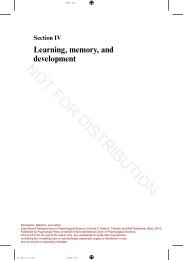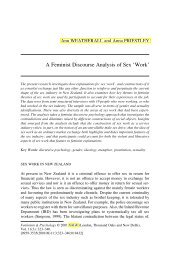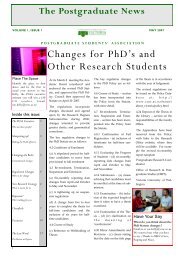green & myerson 2004.. - of /courses
green & myerson 2004.. - of /courses
green & myerson 2004.. - of /courses
Create successful ePaper yourself
Turn your PDF publications into a flip-book with our unique Google optimized e-Paper software.
Green and Myerson Page 28 <strong>of</strong> 48<br />
NIH-PA Author Manuscript NIH-PA Author Manuscript NIH-PA Author Manuscript<br />
Conclusion<br />
We have reviewed the results <strong>of</strong> numerous studies in order to show that the discounting <strong>of</strong> both<br />
delayed and probabilistic rewards is well described by the same form <strong>of</strong> mathematical function<br />
(a hyperbola or a hyperbola-like function). The form <strong>of</strong> the discounting function may explain<br />
two findings that represent anomalies from the perspective <strong>of</strong> microeconomic decision theory.<br />
One such anomaly is the reversal in preference that may occur when the point in time at which<br />
choices between smaller, sooner and larger, later rewards is varied. The other anomaly is the<br />
observation that preference may reverse when the probabilities <strong>of</strong> smaller, more certain and<br />
larger, less certain rewards are both reduced.<br />
The finding that temporal and probability discounting functions have the same mathematical<br />
form suggests that there may be similarities in the underlying decision-making processes—<br />
and could even indicate that the same process is involved in the discounting <strong>of</strong> both delayed<br />
and probabilistic rewards. Recent studies, however, have revealed differences between<br />
temporal and probability discounting that raise questions as to the validity <strong>of</strong> a single-process<br />
account. For example, inflation appears to affect how steeply delayed rewards are discounted<br />
but does not affect the discounting <strong>of</strong> probabilistic rewards. More striking, amount <strong>of</strong> reward<br />
has opposite effects on the rates <strong>of</strong> temporal and probability discounting. These and other<br />
dissociations are inconsistent with the claim that one type <strong>of</strong> discounting is more fundamental,<br />
and they imply that there may be at least two distinct discounting processes. Nevertheless, the<br />
present effort exemplifies the advantage <strong>of</strong> describing both temporal and probability<br />
discounting using the same hyperbola-like function. After all, if one only analyzed the effects<br />
<strong>of</strong> delay and probability by fitting different equations to each, it would be difficult to evaluate<br />
whether the effects <strong>of</strong> these variables on subjective value reflect the same or different processes.<br />
That is, any differences observed might reflect merely the different types <strong>of</strong> analyses.<br />
In the present case, temporal and probability discounting data were both analyzed using<br />
discounting functions <strong>of</strong> the same mathematical form, and the different patterns <strong>of</strong> results<br />
obtained strongly suggest that different processes are involved. In particular, the different<br />
effects <strong>of</strong> amount <strong>of</strong> reward on the two parameters <strong>of</strong> the hyperbola-like discounting function<br />
may have implications for how to interpret these parameters. Recall that with delayed rewards,<br />
amount was inversely related to the value <strong>of</strong> the discount rate parameter k but had no effect on<br />
the value <strong>of</strong> the exponent s (e.g., Myerson & Green, 1995), whereas with probabilistic rewards,<br />
amount did not affect the value <strong>of</strong> the discount rate parameter h but was directly related to the<br />
value <strong>of</strong> the exponent (Myerson et al., 2003).<br />
These findings provide some support for the mathematical model proposed by Myerson and<br />
Green (1995), but the model does not predict the entire pattern <strong>of</strong> results. That is, the finding<br />
that for delayed rewards, exponents are independent <strong>of</strong> amount as well as the finding that the<br />
exponents for delayed and probabilistic rewards are different (Myerson et al., 2003) are both<br />
consistent with the view that the process <strong>of</strong> estimating the subjective value <strong>of</strong> a delayed reward<br />
involves fundamental psychophysical scaling processes and that such scaling is captured by<br />
the exponent parameter. According to a psychophysical scaling interpretation like that<br />
proposed by Myerson and Green, the degree <strong>of</strong> nonlinearity is a fundamental property <strong>of</strong> the<br />
variable (i.e., delay and probability) being scaled (Stevens, 1957). Therefore, the exponents<br />
for temporal and probability discounting may well differ, but within each choice domain, the<br />
exponent should not be influenced by the amount <strong>of</strong> the reward. Although this prediction was<br />
confirmed for delayed rewards, it was not supported in the case <strong>of</strong> probabilistic rewards where<br />
larger amounts were associated with larger exponents (Myerson et al., 2003).<br />
Psychol Bull. Author manuscript; available in PMC 2006 February 24.






